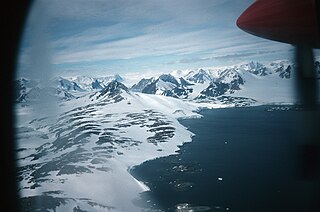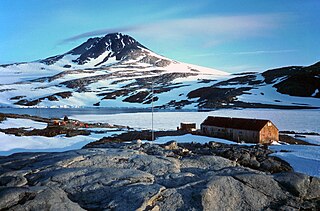
Thurston Island is an ice-covered, glacially dissected island, 215 km (134 mi) long, 90 km (56 mi) wide and 15,700 km2 (6,062 sq mi) in area, lying a short way off the northwest end of Ellsworth Land, Antarctica. It is the third largest island of Antarctica, after Alexander Island and Berkner Island.

Coronation Island is the largest of the South Orkney Islands, 25 nautical miles (46 km) long and from 3 to 8 nautical miles wide. The island extends in a general east-west direction, is mainly ice-covered and comprises numerous bays, glaciers and peaks, the highest rising to 1,265 metres (4,150 ft).

The Chippewa River is a stream in the U.S. state of Michigan that runs 91.8 miles (147.7 km) through the central Lower Peninsula. The Chippewa is a tributary of the Tittabawassee River and is thus part of the Saginaw River drainage basin. The river is named after the Chippewa people.
The Black River is a 41.1-mile-long (66.1 km) river on the Upper Peninsula of the U.S. state of Michigan, flowing mostly in Gogebic County into Lake Superior at 46°40′03″N90°02′57″W. Its source at 46°18′54″N90°01′15″W is a boreal wetland on the border with Iron County, Wisconsin. The northern section of the river, 14 miles (23 km) within the boundaries of the Ottawa National Forest, was designated a National Wild and Scenic River in 1992.

The Bay of Isles is a bay 9 miles (14 km) wide and receding 3 miles (5 km), lying between Cape Buller and Cape Wilson along the north coast of South Georgia. It was discovered in 1775 by a British expedition under James Cook and so named by him because numerous islands lie in the bay. Of South Georgia's 31 breeding bird species, 17 are found here.
East Skerry is a small group of islands and rocks (skerries) forming the eastern part of the Skrap Skerries, lying 2 miles (3 km) northwest of Cape George, off the north coast of South Georgia. The name was applied in the period 1926–30 by Discovery Investigations personnel who charted these islands.
West Skerry is a small group of islands and rocks forming the west part of Skrap Skerries, lying 3.2 km east of Barff Point off the north coast of South Georgia. The name appears on a chart based upon a survey of this area by DI personnel in the period 1926-30, but it may reflect an earlier naming by whalers.
Skrap Skerries are two small groups of islands and rocks (skerries) lying midway between Cape George and Barff Point, close off the north coast of South Georgia. The present name, which dates back to about 1930, derives from the Norwegian term "skrapskjaer" or "skrapskjar" formerly used for these islands.

Austskjera is a group of rocks (skerries) in Antarctica, lying close to the coast about 9 kilometres (5 nmi) east of Cape Daly, 4 kilometres (2 nmi) east-southeast of Safety Island, and 3 kilometres (1.5 nmi) east-southeast of Landmark Point. They were mapped by Norwegian cartographers from aerial photographs taken by the Lars Christensen Expedition, 1936–37, and named "Austskjera".

The Beaumont Skerries are two small islands and several rocks 2 kilometres (1 nmi) east of the Joubin Islands, off the southwest coast of Anvers Island. They were named by the Advisory Committee on Antarctic Names for Malcolm J. Beaumont, an Electronics Technician in RV Hero on her first Antarctic voyage, reaching nearby Palmer Station on Christmas Eve, 1968.

Benn Skerries are a small group of rocks which extend up to 0.25 nautical miles (0.5 km) westward from Norvegia Point on the island of Bouvetøya. They were charted and named in December 1927 by a Norwegian expedition in the Norvegia under Captain Harald Horntvedt.

The Child Rocks are a group of rocks at the west end of the Robinson Group off the coast of Mac. Robertson Land, 3.7 kilometres (2 nmi) west of Andersen Island. They were mapped by Norwegian cartographers from air photos taken by the Lars Christensen Expedition, 1936–37, and named "Vestskjera". They were renamed by the Antarctic Names Committee of Australia for J.B. Child, Third Officer of the RSS Discovery during the British Australian New Zealand Antarctic Research Expedition, 1929–31.
Whale Skerries is a small group of islands and rocks in Lewthwaite Strait in the South Orkney Islands, lying close west of Cape Disappointment, Powell Island. First charted and named "Hvalskjaer" by Petter Sorlle in 1912-13. The name was later corrected to the plural form, "Hvalskjaerene", by Sorlle. The English form of the name was recommended by the United Kingdom Antarctic Place-Names Committee (UK-APC) in 1954.
Stayaway Skerries is a group of rocks and low-lying reefs awash, lying 1.5 nautical miles (2.8 km) south of Cape Monaco, off the southwest coast of Anvers Island in the Palmer Archipelago. Surveyed by the British Naval Hydrographic Survey Unit in 1956-57. So named by the United Kingdom Antarctic Place-Names Committee (UK-APC) as a caution to mariners; the group has patches of shoal water extending for some distance from it and should be given a wide berth.
Rigel Skerries is a chain of islands and rocks in the northwest part of the Oygarden Group, lying in the south part of the entrance to Edward VIII Bay in Antarctica. Mapped by Norwegian cartographers from aerial photos taken by the Lars Christensen Expedition, 1936–37, and called Utskjera. The group was first visited by an ANARE party in 1954; these skerries were renamed by Antarctic Names Committee of Australia (ANCA) after the star Rigel which was used for an astrofix in the vicinity.










